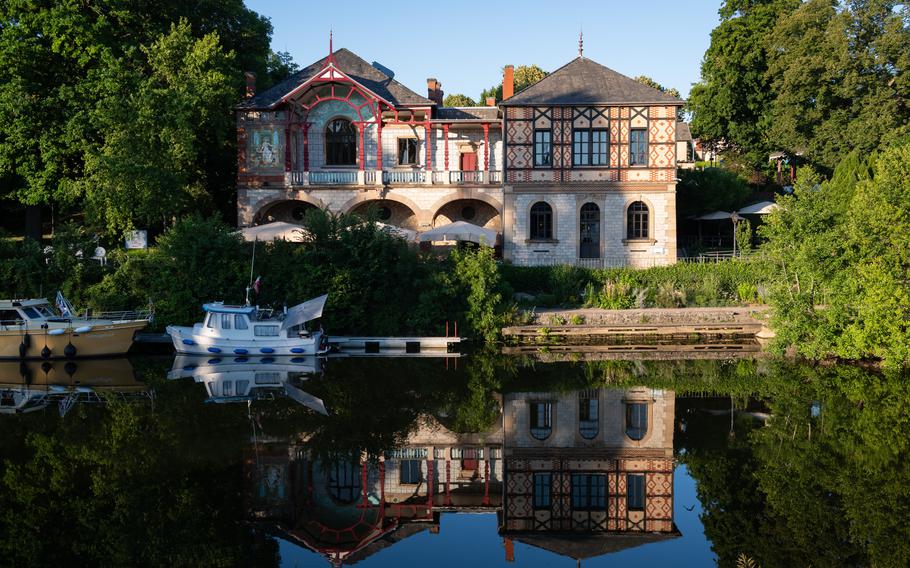
The Casino des Fainceries is one of the most iconic landmarks in the French town of Sarreguemines, which is on the border with Germany. The restaurant in the building has an outdoor seating area along the Saar River and is the town’s most scenic al fresco dining spot. (Phillip Walter Wellman/Stars and Stripes)
“Today, it’s free,” said the man at the Faience Museum, the site in Sarreguemines dedicated to the bygone days of ceramics glory, gesturing for me to enter.
That should have tipped me off that this wasn’t an ordinary Sunday in this French town bordering Germany. About 45 minutes later, a band in Elvis-style suits and afro wigs was marching down the street.
I’d come to Sarreguemines, about an hour’s drive west of Ramstein Air Base, expecting to spend a summer day strolling down lazy streets.
After all, apart from its location at the confluence of the Saar and Blies rivers, Sarreguemines is best-known for its centuries-old production of faience earthenware, which doesn’t scream liveliness.
But my visit coincided with the St. Paul street arts festival, the town’s largest annual celebration.
Soon another group of musicians appeared, these ones dressed as cavemen with mohawks. Down a different street, a woman with a heavy accent sang an Adele song, or at least tried to. And in another corner, a circus artist did tricks on a pole.
Although the festival was an amusing and unexpected addition, the town’s enduring landmarks nevertheless stole the show. I started with the Faience Trail, a journey into the town’s industrial past.
In the 1800s, Sarreguemines became internationally renowned for its faience decorated with an opaque glaze particularly popular during the Art Nouveau and Art Deco periods.
The first stop is the aforementioned museum, which provides English brochures about all five trail locations and recounts the industry’s history, from the founding of the first factories during the French Revolution to their closure in 2007.
The Faience Museum’s showpiece is the Winter Garden, a room whose walls are covered in decorative faience that originally was part of a private home owned by Paul de Geiger, director of the Sarreguemines Faience Works.
Just behind the museum stands a 36-foot-high brick kiln that was used from the 1860s to the 1940s. From there, a short walk across a footbridge over the Saar brings you to the Casino des Faïenceries, one of Sarreguemines’ most iconic landmarks.
With its arched windows and decorative ceramic facade, the building once served as a social and cultural center for factory workers and local elites rather than a gambling establishment, like its name suggests.
Today, it hosts public events and performances and includes a restaurant. Its outdoor riverside seating area, beneath a large faience mural, offers the town’s most scenic al fresco dining spot.
A housing estate for ceramics workers built behind the casino is still occupied today and is included on the tour route.
Outside town is the Moulin de la Blies, or Blies Mill, the trail’s final stop. Once a ceramics production site, it now houses a museum that showcases the former mill operations and displays ceramic-making tools and machinery.
It also features a large garden built amid the old factory ruins, probably my favorite place in Sarreguemines. In the Labyrinth of Ruins, the crumbling, overgrown walls are said to evoke nature’s ability to transform.
Situated along the small, languid Blies River, the garden is an ideal picnic spot, with Germany just across the water.
Back in the town center, the separate Historical-Architectural Tour takes visitors through Sarreguemines’ medieval heart. Numbered signs designating key landmarks are easy to follow. I started at the 10th and final stop in front of the Palais de Justice and worked backward.
Some stops are better than others. The medieval fortress ruins were a bit underwhelming, and the park surrounding them had an almost sketchy vibe.
By contrast, Rue d’Or, one of the town’s oldest streets, features a row of charming 18th- and 19th-century houses. And on the adjacent Rue de la Charrue, it’s possible to walk in the footsteps of a giant blacksmith who once lived there, or so the legend goes.
One of the most beautiful structures in the area is the Fischer House, an Art Nouveau building from the early 1900s adorned with ornamental ceramic details. Today, the ground floor is home to Vesuvio, a popular Italian restaurant.
After a late lunch there, I popped into a perfumery and a patisserie, which remained open late on a Sunday because of the festival, and eventually found myself at Le Bounty, a busy pirate-themed crepe shop and ice cream parlor.
The eatery has been operating for more than three decades and serves ice cream in plastic sundae holders shaped like exotic birds and pirates. I ordered an ice cream dish covered in Nutella and chatted with the server.
He told me the town hosts several festivals each year but none quite like St. Paul. I said I was impressed and wanted to bring friends to next year’s edition, possibly check out some of the other festivals he described.
“Yes,” he said, nodding. “We’re a small town, but we do a lot.”
On the QT
Where: About 40 miles southwest of Ramstein Air Base
Hours: Faience Museum and Blies Mill are open from Tuesday to Sunday and on public holidays. Museum, 10 a.m.-noon and 2-6 p.m.; mill, November through March, 10 a.m.-noon and 2-6 p.m., and April through October, 10 a.m.-6 p.m.
Costs: Entry to the Faience Museum and Blies Mill is 6 euros, free for visitors 17 and under. Free parking at the train station.
Information: Online: sarreguemines-tourisme.com/en